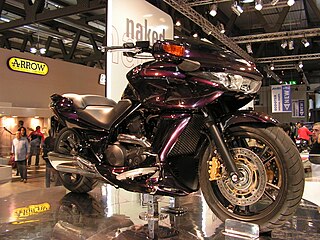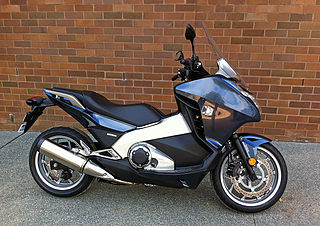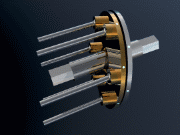
An automatic transmission is a multi-speed transmission used in internal combustion engine-based motor vehicles that does not require any driver input to change forward gears under normal driving conditions. It typically includes a transmission, axle, and differential in one integrated assembly, thus technically becoming a transaxle.

The Honda VF and VFR series is a range of motorcycles first introduced in 1982 by Honda featuring V4 engines.

The Honda Insight is a hybrid electric vehicle that is manufactured and marketed by Honda. Its first generation was a two-door, two passenger liftback (1999–2006) and in its second generation was a four-door, five passenger liftback (2009–2014). In its third generation, it became a four-door sedan (2019–present). It was Honda's first model with Integrated Motor Assist system and the most fuel efficient gasoline-powered car available in the U.S. without plug-in capability — for the length of its production run.

Variomatic is the continuously variable transmission (CVT) of the Dutch car manufacturer DAF, originally developed by Hub van Doorne. It is a stepless, fully-automatic transmission, consisting of a V-shaped drive-belt, and two pulleys, each of two cones, whose effective diameter can be changed so that the "V" belt runs nearer the spindle or nearer the rim, depending on the separation of the cones. These are synchronized so that the belt always remains at the same optimal tension.

Propulsion transmission is the mode of transmitting and controlling propulsion power of a machine. The term transmission properly refers to the whole drivetrain, including clutch, gearbox, prop shaft, differential, and final drive shafts. In the United States the term is sometimes used in casual speech to refer more specifically to the gearbox alone, and detailed usage differs. The transmission reduces the higher engine speed to the slower wheel speed, increasing torque in the process. Transmissions are also used on pedal bicycles, fixed machines, and where different rotational speeds and torques are adapted.

A continuously variable transmission (CVT) is an automatic transmission that can change seamlessly through a continuous range of gear ratios. This contrasts with other transmissions that provide a limited number of gear ratios in fixed steps. The flexibility of a CVT with suitable control may allow the engine to operate at a constant RPM while the vehicle moves at varying speeds.
A semi-automatic transmission is a multiple-speed transmission where part of its operation is automated, but the driver's input is still required to launch the vehicle from a standstill and to manually change gears. Most semi-automatic transmissions used in cars and motorcycles are based on conventional manual transmissions or sequential manual transmissions, but use an automatic clutch system. However, some semi-automatic transmissions have also been based on standard hydraulic automatic transmissions with torque converters and planetary gearsets.

Multitronic is a stepless transmission launched by AUDI AG in late 1999, jointly developed and manufactured by LuK. The capitalization used is multitronic and is a registered trademark of AUDI AG.

The Honda Airwave is a subcompact car produced by the Japanese automaker Honda from 2005 to 2010. It was a five-door station wagon version of the first generation City/Fit Aria and Fit/Jazz, which was a sedan and a hatchback respectively. The Airwave was built on the Global Small Car platform; however, unlike the City and Fit, the Airwave was unique to the Japanese market. Honda announced the debut of the Airwave on April 7, 2005.
The GY6 engine design is a four-stroke single-cylinder in a near horizontal orientation that is used on a number of small motorcycles or scooters made in Taiwan, China, and other southeast Asian countries. It has since become a generic technology. Kymco went on to produce Honda clones such as the Pulsar (CB125), made to Honda standards, as part of their range.

An underbone is a type of motorcycle that uses structural tube framing with an overlay of plastic or non-structural body panels and contrasts with monocoque or unibody designs where pressed steel serves both as the vehicle's structure and bodywork. Outside Asia, the term underbone is commonly misunderstood to refer to any lightweight motorcycle that uses the construction type, known colloquially as step-throughs, mopeds or scooters.

Yamaha YP 400 Majesty is a scooter made by Yamaha beginning in 2003. The Majesty line includes 150, 250, and 400 cc displacement single-cylinder engine versions available in Europe and Asia. In the US, only the 400 cc model was sold, from 2004 to 2014.

A scooter is a motorcycle with an underbone or step-through frame and a platform for the rider's feet, emphasizing comfort and fuel economy. Elements of scooter design were present in some of the earliest motorcycles, and scooters have been made since at least 1914. Scooter development continued in Europe and the United States between the World Wars.

The Honda DN-01 is a cruiser motorcycle made by Honda from 2008 to 2010. It was introduced at the 2005 Tokyo Motor Show and went on sale in Japan and Europe in 2008, in the United States in 2009, and was discontinued at the end of 2010.

The Honda VFR1200F is the 7th generation Honda sport touring motorcycle from the VF and VFR line motorcycles powered by a transverse mounted V4 engine. The VFR1200F has several new technologies including the first dual clutch transmission offered on a motorcycle.

The Aprilia Mana 850 is an automatic transmission motorcycle made by Aprilia since 2007.

A motorcycle transmission is a transmission created specifically for motorcycle applications. They may also be found in use on other light vehicles such as motor tricycles and quadbikes, go-karts, offroad buggies, auto rickshaws, mowers, and other utility vehicles, microcars, and even some superlight racing cars.

The Honda NC700D/NC750D Integra is a motorcycle/scooter hybrid made by Honda since 2012. Known internally as the RC62, the Integra was originally unveiled as the New Mid Concept in 2010, before being presented in production form at EICMA 2011 in Milan. The Integra shares a platform with two motorcycle variants, the NC700S (RC61) and the NC700X (RC63). All three variants are powered by a 670 cc engine derived from the unit used in the Honda Fit automobile. The Integra will be available with two different power outputs, one version develops a peak power output of 38.1 kW (51.1 hp) at 6,250 rpm and 62 N⋅m (46 lb⋅ft) of torque at 4,750 rpm, while the other has a lower output of 35 kW (47 hp) and 60 N⋅m (44 lb⋅ft) to meet 2013 A2 European licensing regulations.

The Honda NC700 series is a family of motorcycles produced by Honda since 2012. NC700 series was a 'new concept', being unlike conventional motorcycles, a bike designed for commuters, new or veteran riders. The series also includes the motorcycle/scooter hybrid NC700D Integra. The NC700 series is classed as a commuter model bike which has incorporated design and mechanical elements from various motorcycle types. The riding position is similar to standard bike styles. There is a helmet-sized internal storage in place of the traditional fuel tank, which in turn is located under the seat. The series is often marketed as fun to ride, easy to handle and very fuel efficient.

The first generation Honda Fit is a subcompact car or supermini manufactured by Honda from 2001 to 2008. It debuted in June 2001 in Japan and subsequently was introduced in Europe, Australia, South America, South Africa and Southeast Asia (2003), China, and Mexico.



















